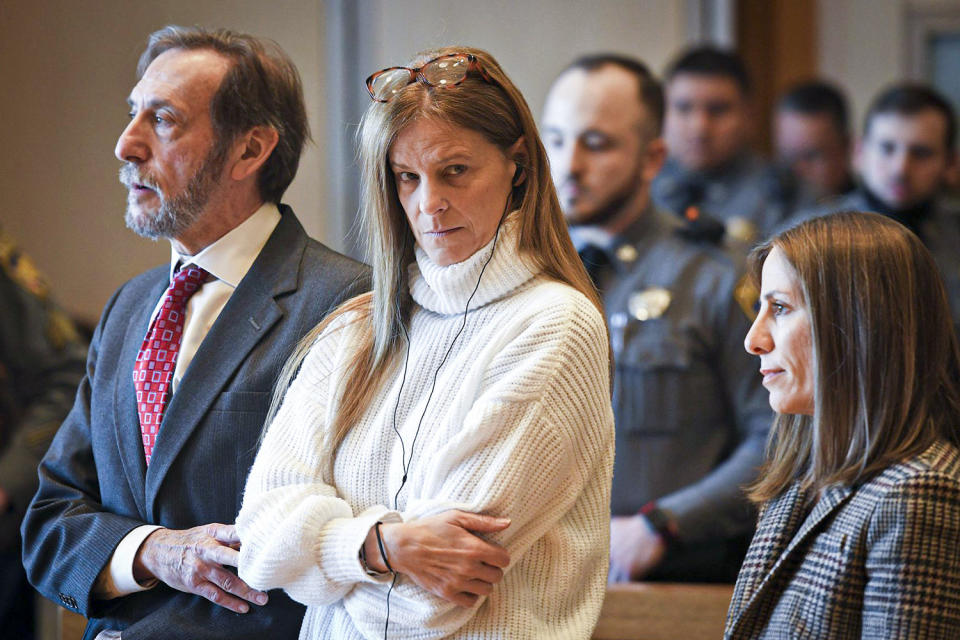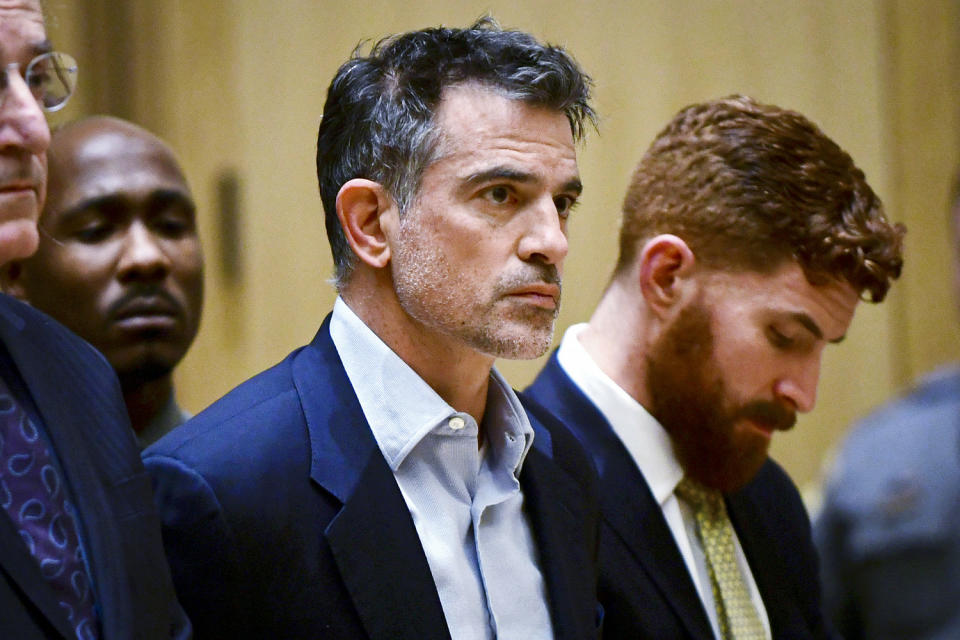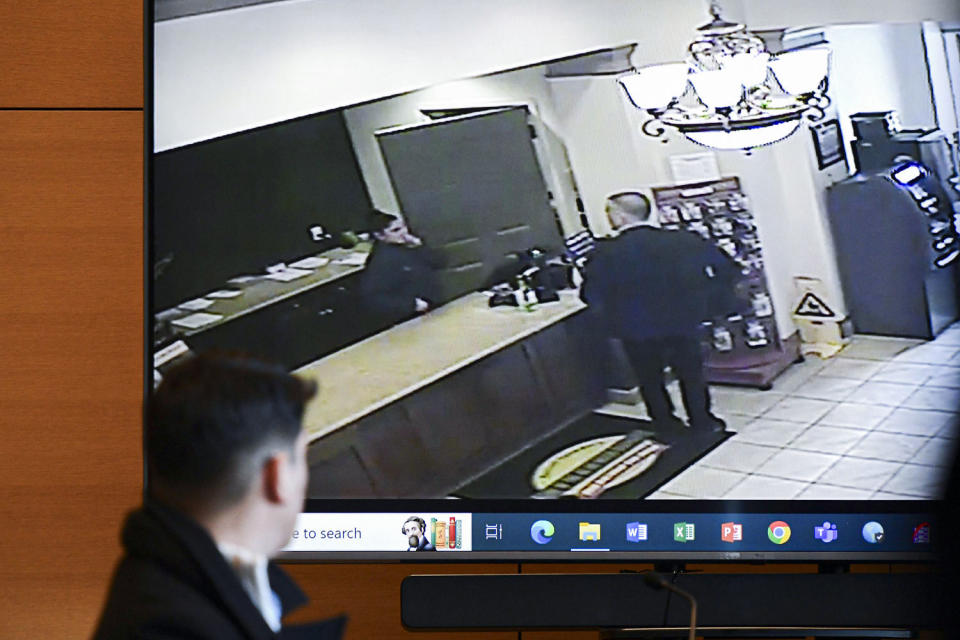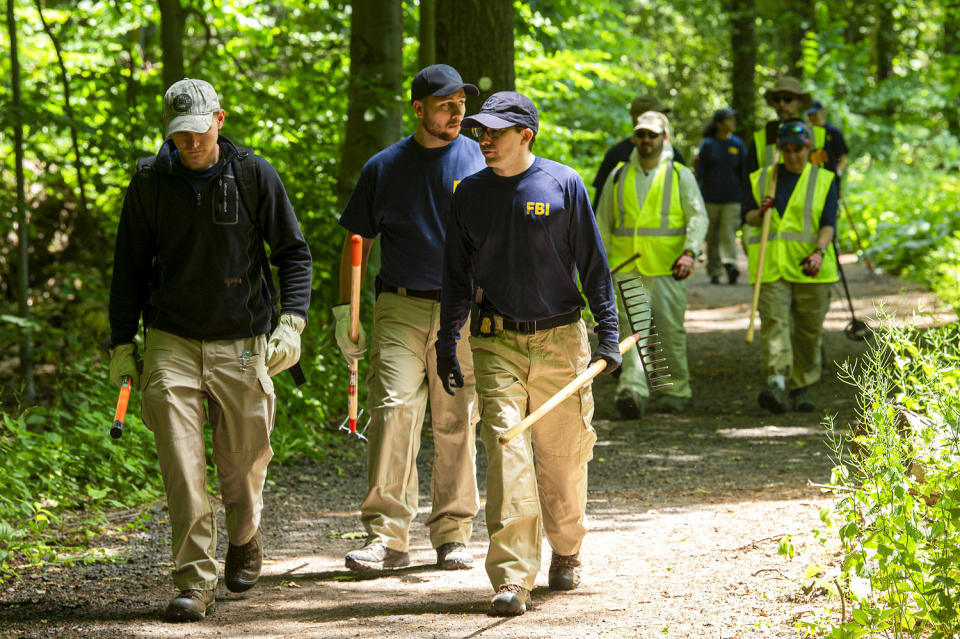Caught on camera: How a flood of video helped authorities get a conviction in the death of a missing Connecticut mother
- Oops!Something went wrong.Please try again later.
Prosecutors had no eyewitnesses linking a Connecticut woman to the death of a mother of five who disappeared in 2019, but authorities turned to another crucial piece of evidence to help convict Michelle Troconis in the murder of Jennifer Dulos — hours of video culled from security and surveillance cameras across the state.
Troconis, the girlfriend of Dulos’ estranged husband, was found guilty Friday of conspiracy to commit murder, tampering with evidence and hindering prosecution; she faces up to 50 years in prison when she is sentenced in May.
The case against her and Fotis Dulos, who died in 2020 after he was charged in Jennifer’s death, was partly built around a timeline investigators stitched together using clips from residential security systems, a sprawling network of urban police cameras, and even passing school buses.
They captured the movements of a man authorities alleged was Fotis Dulos across 14 hours and a wide swath of Connecticut on May 24, 2019, the day Jennifer Dulos disappeared. Her body has never been found, but a judge issued her declaration of death last year.
The staggering amount of video evidence in the case reflects what Grant Fredericks, a longtime forensic video analyst who has taught for the FBI, described as an increasingly common reality for law enforcement agencies — a reality partly fueled by the boom in residential “smart” cameras and aided by new software from Axon, the Taser and body camera maker.
The Hartford Police Department, which operates some of the cameras used in the Dulos case, has said its newly expanded network has allowed investigators to solve more crimes. To Fredericks, who was not familiar with the Dulos case, the development has heralded a source of information that is one of the most routinely used by law enforcement today.

That source is usually more reliable than its predecessor, the eyewitness, he said.
“Because of this ubiquity of cameras, every camera is a potential witness, and these witnesses have an accurate recollection of time, date, movement and a visual record,” Fredericks said.
But critics described the rapid growth of video in criminal investigations as an alarming development that can ensnare innocent bystanders and appears to have few guardrails.
“The cameras are everywhere,” said Adam Schwartz, privacy litigation director for the nonprofit digital civil liberties group Electronic Frontier Foundation. “They are networked. The footage can be searched with automated tools. This raises profound concerns.”
Schwartz was not familiar with the Dulos case, and there are no allegations that authorities improperly used video in the investigation.
A timeline takes shape
According to a Hartford Police Department crime analyst who testified at Troconis’ trial, the agency’s “Capital City Command Center” — or the C4, as it’s known — operates a network of more than 1,000 cameras across the city of roughly 120,000 people.

In a news release last year, the communications company that partnered with the department on the C4 said it uses a combination of “pan/tilt/zoom” cameras, license plate readers and ShotSpotter devices, the gunshot detection technology, to allow analysts to “quickly synthesize vast amounts of critical data into actionable intelligence.”
On the night of May 24, 2019, those cameras captured a man authorities identified as Fotis Dulos driving a black Ford pickup that was registered to his luxury homebuilding company, arrest warrants in the case show.
Between 7:31 p.m. and 7:50 p.m., authorities said he was seen on video pulling over on Albany Avenue, roughly 20 miles northeast of his Farmington home, and placing black bags in trash cans, the warrants say. At another point, he was seen placing a FedEx envelope into a storm drain.
Inside the bags, authorities found several items, including zip ties, gloves, a bra and a mop handle, the warrants say. A paper towel and a plastic bag had “bloodlike” stains on them. In the envelope, investigators discovered a set of altered license plates.
Many of the items had Jennifer Dulos’ DNA on them, according to the warrants. A few had DNA or fingerprints that matched Fotis Dulos and Troconis. (Troconis later told authorities she was with Fotis Dulos when he made the stops, though she wasn’t sure what he was doing.)
Videos from earlier in the day showed what authorities alleged were the events before and after Jennifer Dulos’ murder — events that included a red Toyota Tacoma that authorities said belonged to an employee of Fotis Dulos. During Troconis’ trial, prosecutors alleged that Fotis Dulos took the truck and used it to drive it to New Canaan, where his estranged wife lived after the couple separated.
Cameras captured the vehicle leaving Fotis Dulos’ home at 5:35 a.m., according to the warrants. At 7:03 a.m., the truck passed a rest area on Merritt Parkway, the thoroughfare connecting Farmington to New Canaan.
At 7:40 a.m., a school bus camera captured the Tacoma parked in a turnout a few miles from Jennifer Dulos’ home, the warrants say.

A few minutes earlier, at 7:31 a.m., a residential security camera showed someone with dark clothing and a hoodie pulled low over their face pedaling a bike in the direction of Jennifer Dulos’ house.
The bike appeared to match one that belonged to Fotis Dulos, the warrants say, and the recording was captured between the turnout and Jennifer Dulos’ home — a path that authorities allege Fotis Dulos may have followed from the Tacoma location to the home.
At trial, prosecutors alleged that Jennifer Dulos was killed in her garage, where investigators discovered blood spatter that appeared to have been cleaned.
Four hours later, at 11:12 a.m., the Tacoma was captured driving north on Merritt Parkway, with what appeared to be a bicycle in the bed of the truck, the warrants say.
In an interview with “Dateline” before his death, Fotis Dulos declined to discuss details from the case but denied killing his estranged wife. His lawyer, Norm Pattis, told “Dateline” that the man in the truck seen in Hartford could have been his client, but the face was fuzzy and the truck’s license plate wasn’t clear.
“A jury could well conclude that that was Mr. Dulos,” he said. “And that’s a troublesome set of facts for us.”
Pattis did not respond to a request for comment on other videos used in the case.
A crucial tool
Fredericks, the video analyst, wasn’t aware of data showing how much video is used in criminal investigations in the United States today. But when he polls police chiefs in his classes, he said, they typically report that 95% to 100% of their agencies’ investigations involve some video evidence.
Video has become so crucial that investigators often deploy a tactic with potential suspects that appears to be small talk — where do you like to eat dinner? — but is actually aimed at gathering intelligence so investigators can potentially track down video, Fredericks said.
Although there’s been a boom in residential smart cameras in recent years — the market in North America was valued at $2 billion in 2020 and is expected to grow 20% by 2030, an industry analysis shows — the bulk of the video Fredericks sees comes from businesses, he said.
Compared to the amount of video used in most major criminal investigations, the Dulos case is likely an outlier, Fredericks said, since the majority of the country’s 18,000 law enforcement agencies don’t have the capacity or technical skill to appropriately handle video. At the same time, Fredericks said, he’s currently working a case with a similarly outsized amount of video evidence — 2,300 separate recordings from hundreds of different sources.
While many of the country’s smaller or mid-size agencies likely can’t handle significant volumes of video evidence, they can turn to regional forensic labs or state police agencies for help, Fredericks said. The new software from Axon may make things even easier, Fredericks said.

A tool the company released nearly two years ago simplifies the process of gathering video by allowing investigators to easily access and review raw files that are in proprietary formats, as most recordings from home and business security systems are, without creating errors, Fredericks said.
As of February, the software had nearly 280,000 users around the world, Fredericks said, noting that Axon provided him with that data while he was preparing for a recent trial. An Axon spokesperson declined to comment on the number of people who use the software, their locations or what types of agencies they work for.
But the spokesperson said that 18,000 agencies in more than 1000 countries use the company’s products.
Fredericks said the video software is made for two kinds of investigators — one who's advanced and wants to string together clips into a timeline, and another “who doesn’t know how to spell video.”
“They just want to push play and look at it,” he said.
‘Pervasive and intrusive’
To Schwartz, of the Electronic Frontier Foundation, the rapid growth in video evidence is “increasingly alarming.”
Schwartz said that authorities generally aren’t required to seek a search warrant when pursuing what he described as “pervasive and intrusive” video surveillance, like using a network of cameras to track a specific person over time and develop a detailed picture of their life.
He compared the tactic to obtaining a person’s cell site location information from a phone company — an investigative technique that in 2018 the U.S. Supreme Court ruled requires a search warrant.
Schwartz also pointed to errors linked to video technology used by law enforcement. In a series of separate cases across the United States, at least seven people — six of whom are Black — have alleged that they were wrongfully arrested after being misidentified through facial recognition software, Schwartz said. Researchers have found the technology’s algorithms have performed poorly when identifying people who aren’t white men.

License plate readers — high-speed cameras that photograph and log license plates — have also been scrutinized over allegations of errors and misuse.
In Colorado, a woman was handcuffed and held at gunpoint with relatives after a license plate reader mistakenly identified her plates as stolen. And in New York City, prosecutors charged a man with manslaughter and other crimes after cameras captured his license plate on a car that authorities said was used in a murder-for-hire in the Bronx, his lawyer, Cary London, told NBC News.
The man’s plates had actually been stolen and put on a car that wasn’t his, London said. The man, Anthony Destefano, told authorities he wasn’t anywhere near the scene, but he was charged and held at Rikers Island for nearly a month, London said.
“They put his name in the paper and he lost his job,” London said. “It was really just a nightmare.”
The charges were later dismissed, according to a lawsuit Destefano filed in 2021 alleging wrongful arrest. The case is ongoing, London said.
The Bronx District Attorney’s Office did not respond to a request for comment. An NYPD spokesperson said the department doesn’t comment on pending litigation. A filing from New York City’s Corporation Counsel denied the allegations in the suit.
To London, the case represents the potential perils of a landscape transformed by video.
“The future is here,” he said. “I think we are entering a dangerous area of technology where the police are going to be able to watch everything we do.”
This article was originally published on NBCNews.com

